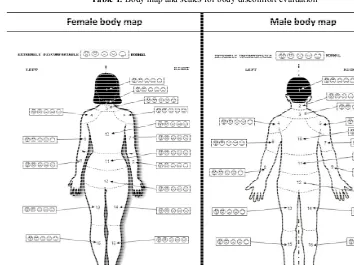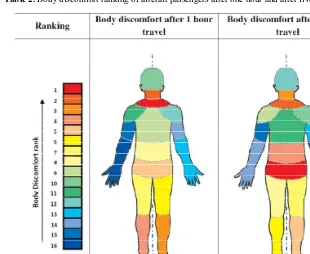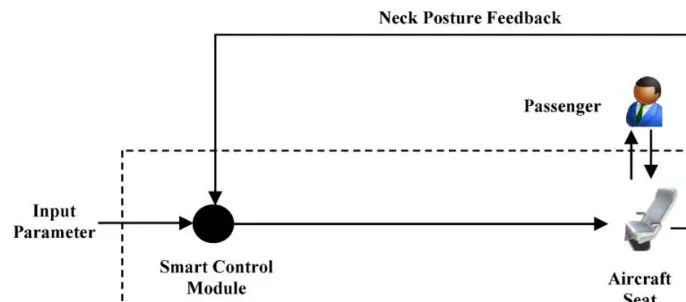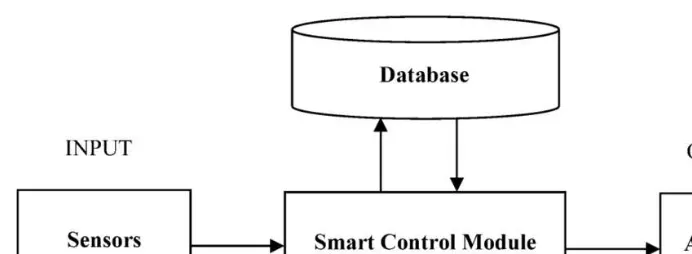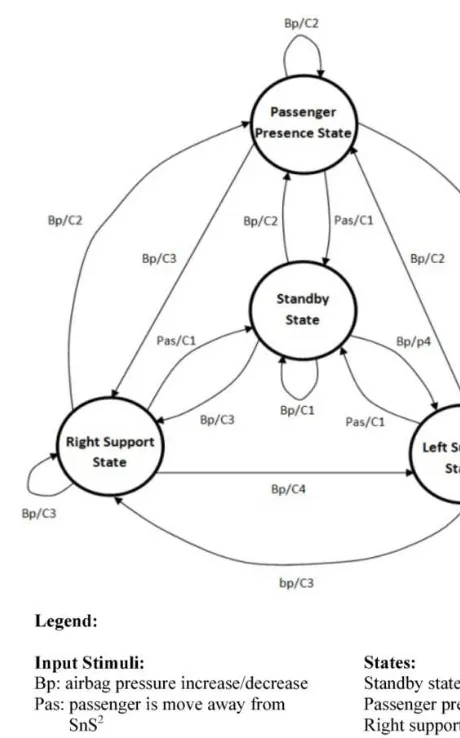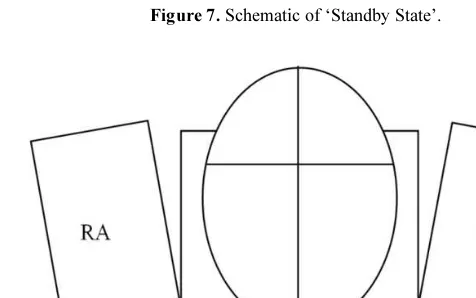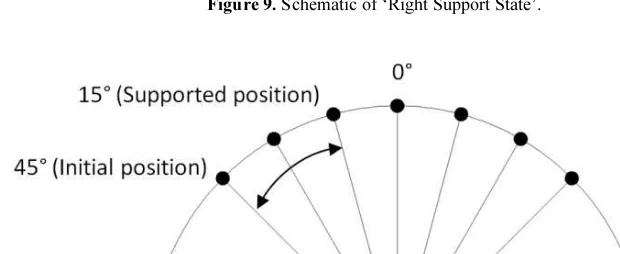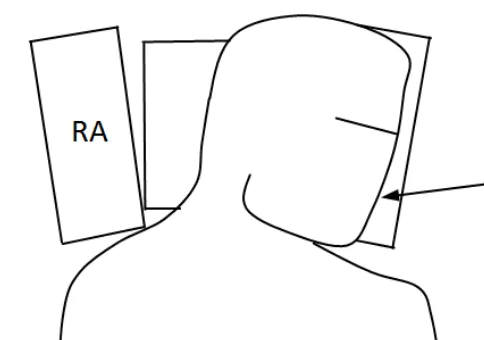Adaptive Neck Support for Wellbeing
During Air Travel
CheeFai TAN a,b,∗, Wei CHEN b
and Matthias RAUTERBERG b
a
Universiti Teknikal Malaysia Melaka, Melaka, Malaysia
b
Department of Industrial Design, Eindhoven University of Technology, Netherlands
Abstract. Air travel is becoming increasingly more accessible to people both through the availability of low cost flights. Health problems may arise due to an-xiety and unfamiliarity with airport departure procedures prior to flying, whilst during the air travel, problems may arise as a result of the food served on board, differences in the environmental conditions inside the cabin, the risk of cross-infection from fellow passengers, seat position, posture adopted and duration of the flight. These can be further compounded by changes in time zones and meal times, which may continue to affect an individual’s health long after arrival at the final destination. The aircraft passenger comfort depends on different features and the environment during air travel. Seat comfort is a subjective issue because it is the customer who makes the final determination and customer evaluations are based on their opinions having experienced the seat. The aircraft passenger seat has an important role to play in fulfilling the passenger comfort expectations. The seat is one of the important features in the passenger aircraft and is the place where the passenger spends most of time during air travel. This chapter describes the de-velopment of adaptive neck support system to improve the wellbeing experience during air travel for economy class aircraft passenger. Design concept, prototyping, system implementation, experimental testing and design evaluation in an aircraft cabin simulator developed at Eindhoven University of Technology will be pre-sented in the chapter.
Keywords. Adaptive, air travel, neck support
Introduction
Travel by air, especially long distance, is not a natural activity for human. Many people experience some degree of physiological and psychological discomfort and even stress during flying. Excessive stress may cause the passenger to become aggressive, over-reaction, and even endanger the passenger’s health [2,6,24]. A number of health prob-lems can affect flying passengers. Seat comfort is an attribute that demand by today’s passenger. The results of seating comfort and discomfort survey [13,14,18] indicated that the neck is one of the most discomfort body parts after one hour and after five hours travel for truck drivers as well as economy class aircraft passengers. In the sur-vey, the neck support is one of the top ranking comfort descriptors for economy class aircraft seat. The observation in the economy class aircraft cabin also indicates that most observed passengers preferred sitting posture with head facing forward. The head
∗Corresponding Author: CheeFai Tan, Senior Lecturer, Department of Design and Innovation, Faculty
of Mechanical Engineering, Universiti Teknikal Malaysia Melaka, Melaka, Malaysia. E-mail: cheefai@utem. edu.my.
J.C. Augusto et al. (Eds.) IOS Press, 2012
facing forward is the most comfortable head position [21]. Therefore, an adaptive sup-port system prototype was developed that focuses on neck. The objective of an adap-tive system is to reduce the neck muscle stress of the economy class passengers during air travel. This chapter describes the development of an adaptive neck support system for aircraft passenger wellbeing during air travel.
1.Current Neck Support for Vehicle Seat
In this subsection, the study on the neck support for long haul travel and vehicle seat e.g. aircraft, bus and train are described.
1.1.Travel Type Neck Support
From the product search using web services, several neck supports related products were found. There are different types of neck supports that are used during air travel such as inflatable neck pillow [9], polyester filled pillow [9], memory foam pillow [9], feather filled pillow [12] and the aircraft seat with mechanical neck support [3,7,16].
Inflatable Neck Pillow
The inflatable neck pillow is low in price and can be found in the travel shop. The air pressure in the inflatable air pillow is proportional to the aircraft flying altitude. When the aircraft flies in the higher altitude, the air pillow will expand and it will contract in the lower altitude. The aircraft passenger will be disturbed by the air pillow when the flying altitude changes. The air pillow holds the passenger’s head in one position and the passenger is unable to change the head posture freely. Most of the inflatable air pillows are made from vinyl material that will cause the user to feel hot and sticky. The advantages of the inflatable pillow are that it is easy to store and light-weight [9].
Memory Foam Travel Pillow
The memory foam travel pillow provides good and comfortable support during travel. The memory foam is able to respond to the passenger’s body shape and to hold the passenger’s head firmly. The memory foam pillow can be compressed into smaller size for storage purpose. The memory foam pillow is light-weight and durable. On the other hand, the memory foam pillow is the most expensive in comparison with commercially available neck support pillows [9].
Polyester Travel Pillow
Feather Filled Pillow
The feather filled pillow is soft and easy to mold around the passenger’s head for better support. The feather filled pillow is light in weight and can be scrunched. On the other hand, the feather filled pillow will sink into some degree when it is used for some time. The passenger needs to adjust the feather filled pillow to its preferred loft from time to time. The feather filled pillow creates noise when passenger moves their head during resting condition [12].
1.2.Long Distance Commercial Vehicle Passenger Seat with Neck Support
The Coach Passenger Seat with Neck Support
Long-distance coach services, e.g. express buses, are transporting passengers from city to city and serve as main commuter for towns without any railway service [22]. The coach passenger seat is one of the important features to ensure the comfort of the pas-senger for long distance travel. For example, an express coach that travels from Singa-pore to Thailand as shown in Fig. 1 was equipped with neck, side and leg support for their passenger’s comfort during long distance bus travel.
The Train Passenger Seat with Neck Support
Long distance high speed railway companies, such as ICE, Thalys and Eurostar offer luxury passenger seat to ensure the seating comfort of passengers during train travel. German ICE offers a passenger seat with the neck support as shown in Fig. 2. The neck support is a soft cushion attached to the seat with two strings.
1.3.The Aircraft Passenger Seat with Neck Support
The economy class seat of major airlines such as KLM, Malaysia Airlines, Qantas Air-lines and Cathay Pacific AirAir-lines are equipped with adjustable head rest to improve the head and neck comfort during air travel. The headrest of an economy class seat is a mechanical device that supports head and neck. The device needs to be adjusted ma-nually by the passenger for comfort improvement. The headrest (Fig. 3) available in the
economy class aircraft seat of Cathay Pacific Airlines can be adjusted in four ways – up, down and sideways (with the adjustable ears). The headrest aims to maximize comfort and support for the passenger’s head and neck [3]. Most of the headrests available in current aircrafts [3,7,11] are a mechanical system where the passenger needs to adjust the head rest manually to the required position.
2.Survey of Body Discomfort for Economy Class Aircraft Passenger
Long haul economy class aircraft passengers are at risk of discomfort for long sitting and experience significant discomfort at different body parts. This study was set out to examine the relationship between body discomfort and travel time for economy class aircraft passengers. There were 104 anonymous questionnaires completed at Schiphol International Airport, the Netherlands, from October through November 2008.
2.1.Methods
The objective of the questionnaire is to investigate the seating discomfort for economy class aircraft passengers over travel time. The questionnaire consists of three sections: (1) questions about the respondents’ air travel frequency per year, common flight
dura-Figure 2. The German train ICE passenger seat with neck support.
tion and the travel class; (2) questions about their discomfort level for each body part after one hour and five hours flight; (3) questions about demographic background of respondents.
The questionnaire begins with a short, self-explanatory introduction in which the purpose and background of the survey are explained; it is also emphasized that data will be treated with confidentiality and analyzed in an anonymous manner.
The respondents were asked to report on travel frequency in a four point scale (1 = 1 time, 2 = 2–5 times, 3 = 6–10 time, 4 = 11 times or more), common flight dura-tion in a four point scale (1 = less than one hour, 2 = 2–5 hours, 3 = 6–10 hours, 4 = 11 hours or more) and the travel class in a three point scale (1 = economy class, 2 = busi-ness class, 3 = first class). The questionnaire was devised to identify the body part dis-comfort, to indicate the discomfort level for each defined body part after one hour and after five hours travel. In order to identify the body part discomfort level, a body map-ping method is used. The body map and scales were used for discomfort assessment. In this method, the perception of discomfort is referred to a defined part of the body. The subject is asked for the discomfort experiences during flight for each defined body part. The scales are graded from ‘extremely discomfort’ to ‘normal’. The body map and scales of body discomfort evaluation for economy class aircraft seat is shown in Ta-ble 1.
The questionnaire was completed by 104 aircraft passengers who were randomly sampled at Schiphol International Airport in the Netherlands. The investigator was present on each occasion, during which aircraft passengers were approached and the aims of the investigation were briefly outlined. The questionnaire with female body
map was distributed to female respondents and the questionnaire with male body map was distributed to male respondents. Approximately 90% of those approached accepted to participate. The questionnaire took between three to five minutes for self-completion.
2.2.Results
The nonparametric Friedman test was used to test the mean rank of the sixteen body parts. For each body part, the sixteen body parts were ranked from 1 to 16 based on body discomfort rating score. The test statistic is based on these ranks. From the result of body discomfort after one hour travel, it showed that shoulder (MR = 10.57) exhi-bited the highest discomfort ranking. It was followed by neck (MR = 10.37) and right lower leg (MR = 10.29). The difference in medians among 16 body discomfort after one hour travel, is significant χ2 (15, N = 104) = 286.27, p < 0.001. For the body dis-comfort level after five hours travel, the result showed that buttocks (MR = 10.74) was ranked as the highest discomfort level after five hours travel. It was followed by shoul-der (MR = 10.24) and neck (MR = 10.15). The difference in medians among 16 body discomfort after one hour travel, is significant χ2 (15, N = 104) = 312.93, p < 0.001. Univariate analysis of variance was conducted to find the differences of body discom-fort level between after one hour travel and after five hours travel. The results showed the body discomfort level after five hours travel was higher than after one hour travel. The detailed comparison between body discomfort ranking after one hour travel and after five hours travel is shown in Table 2.
2.3.Discussion and Conclusion
There were 104 respondents who filled up the questionnaire about body discomfort after one hour and after five hours travel. In line with the survey hypothesis, findings confirmed that the body discomfort of aircraft passenger after five hours travel is high-er than afthigh-er one hour travel. The body discomfort of economy class aircraft passenghigh-ers was associated with flight duration. The finding also showed that the neck is one of the top three most discomfort body part after one hour and after five hours of travel. The result of the study on body discomfort of economy class aircraft passenger demon-strates the need for the development of a neck support system.
3.Adaptive Neck Support System
An adaptive neck support systemis developed to reduce neck muscle stress during air travel for economy class aircraft passenger seat. Feedback loop for adaptive neck sup-port system is illustrated in Fig. 4. The system commences by detecting the passenger’s head posture. Two air pressure sensors are embedded in the seat body to detect the head posture of the passenger. Subsequently, the information of the head posture is sent to a smart control module which performs the following functions:
• Providing support to the passenger’s head based on his or her current head
posture.
• Changing the head rotation angle of the passenger to reduce neck muscle
stress in an adaptive and autonomous way. When the smart control module de-tects that the passenger is in low activity and the passenger has been in contact with the airbag for some time, the smart control module will be activated to provide neck support to the passenger. The passenger’s head will be moved towards front facing position, as this would reduce the neck muscle stress and it is known that the head facing front position is the most comfortable posi-tion [21].
3.1.The Architecture of Adaptive Neck Support System
The architecture of an adaptive neck support system is shown in Fig. 5. Both sides of the upper part of the aircraft passenger seat are embedded with air pressure sensors. The sensors are used to detect the passenger’s head posture. The input parameter to the smart control module is the analog value from the air pressure sensor and the potenti-ometer. The air pressure sensor is used to measure the air pressure in the airbag and the potentiometer detects the presence of passenger. The output parameter is the analog value from the smart control module used to control the proportional solenoid valve. The proportional solenoid valve is used to control the air flow to and from the airbag. The smart control module is the core component of the system where it is used to me-diate between sensors and actuators. The air pressure detection model is the main com-ponent in the smart control module. The algorithm for the system is to support the air-craft passenger’s neck adaptively. The database is used to record the airbag pressure as well as to provide input to the smart control module. The output from the system is the actuators. The actuators will change the airbag condition such as inflate and deflate.
3.2.System Design
State Transition Diagram
The state transition diagram (Fig. 6) is used to describe the behavior of an adaptive neck support system. The state transition diagram describes the possible states of the airbags as events occur. Each circle represents a state. All states are inter-related to each other. When the passenger is not in touch with adaptive neck support system, the adaptive neck support system is in the initial airbag pressure condition (C1). For exam-ple, when the passenger head is in contact with the head cushion (Fig. 9) and the sys-tem senses the presence of the passenger (C2), the syssys-tem will move from ‘Stand-by State’ to ‘Passenger Presence State’. If the passenger’s head turns to the right and is in contact with the right airbag for t time (p3), the system will move from ‘Passenger Presence State’ to ‘Right Support State’. Similarly, if the passenger’s head turns to the left and is in contact with the left airbag for t time (C4), the system will move from ‘Passenger Presence State’ to ‘Left Support State’. When the passenger leaves the sys-tem, all states will transit to ‘Standby State’ and become condition one (C1).
Figure 6. State transition of an adaptive neck support system.
State Transition Description for Smart Neck Support System
State transition is used to describe the behavior of an adaptive neck support system. There are four transition states of an adaptive neck support system. The description of the state transition for an adaptive neck support system is as follows.
Standby State
Figure 7. Schematic of ‘Standby State’.
Figure 8. Schematic of ‘Passenger Presence State’.
Passenger Presence State
The head cushion detects the presence of the passenger. As shown in Fig. 8, the pas-senger’s head is perpendicular to the head support and it is not in touch with the right and left airbag.
Right Support State
Figure 9. Schematic of ‘Right Support State’.
Figure 10. The schematic of example initial position and supported position for right airbag.
Left Support State
In ‘Left Support State’, the passenger’s head is in touch with the left airbag (Fig. 11). The right airbag will be reset to initial state mode. If the passenger’s head is in touch with left airbag and in low activity mode for one minute, the neck support system is activated to give support on the left side of the passenger’s head. The rotation angle of the left airbag for the initial position and the supported position is shown in Fig. 12. During the activation of the system, the airbag will be inflated from initial position (45°) to supported position (15°).
Air Pressure Detection Model
re-cording of air pressure takes place. This because the air that flows into the airbag or exhaust from the airbag will be interfering with the current air pressure value. The model can be easily modified to take into account any variation in the air pressure dur-ing implementation. For example, if the passenger’s head is away from the supported airbag, the current air pressure in the airbag will change.
Let,
Pcurrent = current air pressure in the airbag
Precorded = recorded air pressure when passenger is in touch with the airbag
n1 = value for upper threshold
n2 = value for lower threshold
Pairbag is the difference between the recorded air pressure and the current air
pres-sure. Pairbag is defined as
Pairbag = Precorded – Pcurrent (1)
Pairbag is used for data logging purpose.
Figure 11. Schematic of ‘Left Support State’.
Mathematically,
When passenger is in touch with the airbag,
Pcurrent < Precorded + n1 && Pcurrent > Precorded – n2 comparing the airbag pressure
If the current air pressure in the airbag is within the defined upper threshold and the lower threshold, the SnS2 is activated.
When passenger is away from the airbag that supports the neck,
Pcurrent < Precorded comparing the airbag pressure
The current air pressure in the airbag will decrease to a value that is less than the recorded air pressure when the head is not in touch with airbag. Hence the system can infer that passenger’s head has left the airbag and deactivate the SnS2. The algorithm of air pressure detection model for the right airbag and the left airbag is shown in Fig. 13.
4.Prototype
The final prototype setup is an adaptive neck support system that contains a head cu-shion, a neck cucu-shion, two side airbags, a microcontroller with sensors and actuators connected. The installation of an adaptive neck support system to the economy class aircraft seat in aircraft cabin simulator is shown in Fig. 14. The aircraft cabin simulator is a testbed used for experimental purposes as well as product evaluation purposes.
4.1.Hardware
Arduino Mega [1], transformer, air pressure sensor and proportional solenoid valve were used to build the control system for SnS2. The Arduino MEGA is a microcontrol-ler board based on the ATmega1280. It has 54 digital input/output pins (of which 14 can be used as pulse with modular outputs), 16 analog inputs, 4 UARTs (hardware serial ports), a 16 MHz crystal oscillator, a USB connection, a power jack, an ICSP header and a reset button. Arduino is an open-source electronic device that used for prototyping purpose. The Arduino receives input from sensors and controls the output such as actuator and valve. The communication between the Arduino Mega and the computer is using 9600 baud via USB cable.
The air pressure sensor is a Phidget 1115 [8] type sensor that is used to measure the air pressure inside the airbag. It measures absolute gas pressure from 20 to 250 kPa with a maximum error of ±1.5%. The air pressure sensor is a ratiometric sensor. The membrane potentiometer is a sensor embedded in the head cushion and used to detect the presence of the passenger. The resistance of the membrane potentiometer can be changed linearly from 100 Ohms to 10,000 Ohms [4].
4.2.Software
system. The aims of the developed program are to control the right and the left airbag of an adaptive neck support system.
In term of programming implementation, two programming languages were used in the adaptive neck support system prototype. Arduino programming language [1] was used to program the Arduino microcontroller. The Arduino programming language is based on Wiring [23] and the Arduino development environment was based on Processing [10]. The Arduino programming language is an open-source program and the environment is written in Java. For the database development, we used Processing to write the code. Processing [10] is an open source programming language and envi-ronment for prototyping purposes. Processing was used to log the sensors and actuators data.
5.The Validation of Adaptive Neck Support System
The proposed adaptive neck support system was evaluated in an aircraft cabin simula-tor [15,17,20] as shown in Fig. 14 developed at Department of Industrial Design, Eind-hoven University of Technology. Calibration experiments and evaluation experiments were carried out. The purpose of the calibration experiment [16,19] was to provide in-put such as the neck support condition, time factor and the neck rotation angle to vali-date the adaptive neck support system. In this section, details of the validation experi-ment are reported.
5.1.Participant
Four participants (2 females and 2 males) with no neck pain from the last three months were recruited. They were informed regarding the procedure of experiment such as sitting inside the aircraft cabin simulator for one hour, video recording and attachment of EMG electrodes on their sternocleidomastoid (SCM) muscle.
5.2.Experimental Setup
Two validation experiments were conducted in the aircraft cabin simulator. The loca-tion of experiment is in the simulaloca-tion lab in the main building of Eindhoven Universi-ty of Technology. The first experiment was the aircraft seat without smart system and
the second experiment was the aircraft seat with smart system. Both experiments re-cruited same participant. The observation cameras used to monitor the activity of each participant.
5.3.Apparatus and Data Recording
The hardware used in experiment was MP150 Biopac Systems with (electromyogra-phy) EMG module, aircraft cabin simulator, a adaptive neck support system, computer and observation camera.
Two EMG module of MP150 Biopac system were used for each participant. The aircraft cabin simulator is a test bed was designed and built to simulate the average economy class cabin. Three adaptive neck support systems were installed in each air-craft seat. The computer was used for data logging and video recording. The cameras were installed at the front as well as above the participant. The acquisition of EMG signal and procedure are same as calibration experiment.
5.4.Experimental Procedure
We started the experiment with 30 minutes of briefing to participants and attachment of electrodes on SCM muscles. The participant was performed maximal voluntary con-traction of the SCM by rotate the head to left hand side and right hand side for 10 seconds. After that, we positioned the participant on the economy class aircraft seat. The aircraft seat sitting position was classified as aisle seat, center seat and window seat. Next, light in the aircraft cabin was dimmed and the participant was advised to rest during the one hour experiment. The EMG signals for participants were monitored and recorded in parallel with system log and video recording.
5.5.Data Analysis
For each experiment, the average normalized EMG value was used for statistical analy-sis. A descriptive statistical method was used to analyze the questionnaire. A one-way analysis of variance with repeated measures was used.
5.6.Results
After the experiment, the results from EMG measurements were selected and analyzed. From the statistical result, the mean scores of normalized EMG value for after sup-ported by adaptive neck support system (M = 2.817, SD = 2.130) is lower than the mean scores of normalized EMG value for before supported by adaptive neck support system(M = 3.029, SD = 2.312). The mean scores of normalized EMG value for the participant in relation with neck support activity are shown in Fig. 15.
6.Summary
can improve the aircraft passenger neck comfort. The state transition diagram was used to describe the behavior of an adaptive neck support system. Four transition states were designed and implemented. The air pressure detection model was related to the airbag system. The air pressure detection model is used for the implementation of an adaptive neck support system, the airbag is capable to detect the passenger’s posture and support the passenger’s neck adaptively. The final setup of an adaptive smart neck support sys-tem contains a head cushion, a neck cushion, two side airbags, an Arduino microcon-troller with air pressure sensors and a proportional solenoid valve connected. The open-source programming language, namely Arduino and Processing, were used for pro-gramming implementation in the adaptive neck support system. For the experiment to validate the adaptive neck support system, the results showed that the developed sys-tem is able to provide the necessary neck support to reduce the SCM muscle stress.
References
[1] Arduino, Arduino Mega, http://arduino.cc, accessed on 20 February 2010.
[2] G. Brundrett, Comfort and health in commercial aircraft: A literature review, The Journal of the Royal Society for the Promotion of Health121(1) (2001), 29–37.
[3] Cathay Pacific, Your Guide to the Economy Class Seat, http://downloads.cathaypacific.com/cx/new_ seat/seatguide/Olympus_y.pdf, accessed on 15 February 2010.
[4] Eztronics, Air Pressure Sensor, http://www.eztronics.nl, accessed on 20 February 2010. [5] Five Star Tours, http://www.fivestarsonline.com/?q=en/coach, accessed on 17 June 2010. [6] S. Kalogeropoulos, Sky rage, Flight Safety Australia (1998), 36–37.
[7] Malaysia Airlines, Economy Class, http://www.malaysiaairlines.com/hq/en/flymh/cabin/eclass/econo- my-class.aspx, accessed on 10 February 2010.
[8] Phidgets, http://www.phidgets.com, accessed on 20 February 2010.
[9] Pilot Paul, It’s A Shame For You Not To Use A Travel Neck Pillow To Help You Sleep While Travel-ing – When Other People Do It So Easily, http://www.pilot-pauls-travel-accessories.com/travel-neck-pillow.html, accessed on 15 February 2010.
[10] Processing, http://processing.org/, accessed on 20 February 2010.
[11] Qantas, Qantas A380 Awards, http://www.qantas.com.au/travel/airlines/economy-seat-award/global/en, accessed on 15 February 2010.
[12] N. Robinson, Feather Pillows – Advantages and Disadvantages You Should Know, http://ezinearticles. com/?Feather-Pillows---Advantages-and-Disadvantages-You-Should-Know&id=1122787, accessed on 15 February 2010.
[13] C.F. Tan, Smart System for Aircraft Passenger Neck Support, PhD Thesis, Eindhoven University of Technology, 2010.
[14] C.F. Tan, W. Chen and M. Rauterberg, An approach to study the sitting position and neck discomfort of economy class aircraft passenger during air travel, in: Proceedings of International Conference on Ap-plied Human Factors and Ergonomics, Miami, Florida, USA, Chapter 40, 2010, pp. 376–382. [15] C.F. Tan, W. Chen and M. Rauterberg, Design of aircraft cabin testbed for stress free air travel
experi-ment, in: 5th International Conference on Planning and Design, Tainan City, Taiwan, 2009, p. 157. [16] C.F. Tan, W. Chen and M. Rauterberg, Experimental design for sternocleidomastoid muscle stress
measurement, in: 7th International Conference on Methods and Techniques in Behavioral research, Eindhoven, The Netherlands, 2010, pp. 44–47.
[17] C.F. Tan, W. Chen and M. Rauterberg, Interactive aircraft cabin testbed for stress-free air travel system experiment: An innovative concurrent design approach. In: Proceedings of International Conference on Advances in Mechanical Engineering 2009, Shah Alam, Malaysia, 2009, p. 137.
[18] C.F. Tan, W. Chen and M. Rauterberg, Self-reported seat discomfort amongst Dutch commercial truck driver, in: Proceedings of FISITA 2010, Budapest, Hungary, paper code: FISITA2010/FISITA2010-SC-P-36 (2010).
[19] C.F. Tan, W. Chen and M. Rauterberg, The relationship of head rotation angle and SCM EMG value for the development of AnS2, in: Proceedings of World Congress on Engineering 2010, London, UK, Vol. 3, 2010, pp. 2082–2085.
[20] C.F. Tan, W. Chen and M. Rauterberg, Total design of low cost aircraft cabin simulator, in: Proceed-ings of Design 2010, Cavtat, Croatia, 2010, pp. 1721–17280.
[21] A.R. Tilley and H. Dreyfuss, The Measure of Man And Woman: Human Factors in Design, John Wiley & Sons Inc., New York, 2002.
[22] D. van de Velde, Long Distance Bus Services in Europe: Concession or Free Market, Discussion Paper no. 2009-21, Joint Transport Research Centre, 2009.
[23] Wiring, http://wiring.org.co, accessed on 20 February 2010.
![Figure 1. The luxury coach passenger seat with neck support (Photograph reprinted from [5])](https://thumb-ap.123doks.com/thumbv2/123dok/574110.68033/3.595.115.330.62.213/figure-luxury-coach-passenger-seat-support-photograph-reprinted.webp)
![Figure 3. The Cathay Pacific Airlines economy class aircraft seat with built-in neck suppor (Photograph reprinted from [3])](https://thumb-ap.123doks.com/thumbv2/123dok/574110.68033/4.595.96.371.63.182/figure-cathay-pacific-airlines-economy-aircraft-photograph-reprinted.webp)
